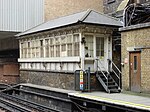All Hallows-on-the-Wall
1767 establishments in England18th-century Church of England church buildingsChurch of England church buildings in the City of LondonChurches bombed by the Luftwaffe in LondonDiocese of London ... and 1 more
Grade I listed churches in the City of London

All Hallows-on-the-Wall is a Church of England church located in the City of London. Its name refers to its location, inside and adjacent to London Wall, the former city wall.
Excerpt from the Wikipedia article All Hallows-on-the-Wall (License: CC BY-SA 3.0, Authors, Images).All Hallows-on-the-Wall
London Wall, City of London
Geographical coordinates (GPS) Address External links Nearby Places Show on map
Geographical coordinates (GPS)
| Latitude | Longitude |
|---|---|
| N 51.516602777778 ° | E -0.084333333333333 ° |
Address
All Hallows On The Wall
London Wall 83
EC2M 5ND City of London
England, United Kingdom
Open on Google Maps








